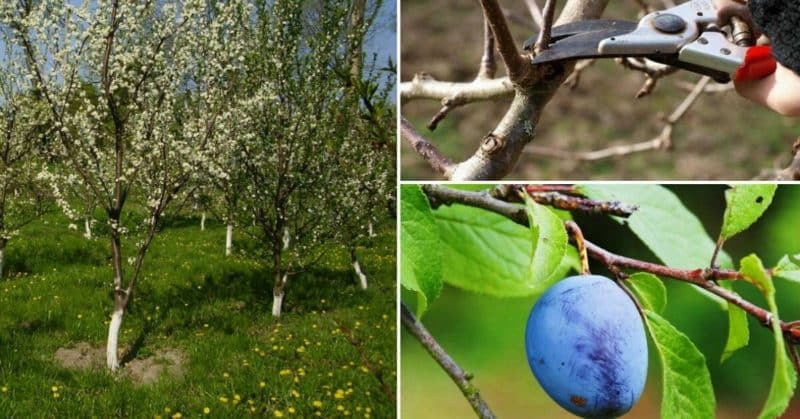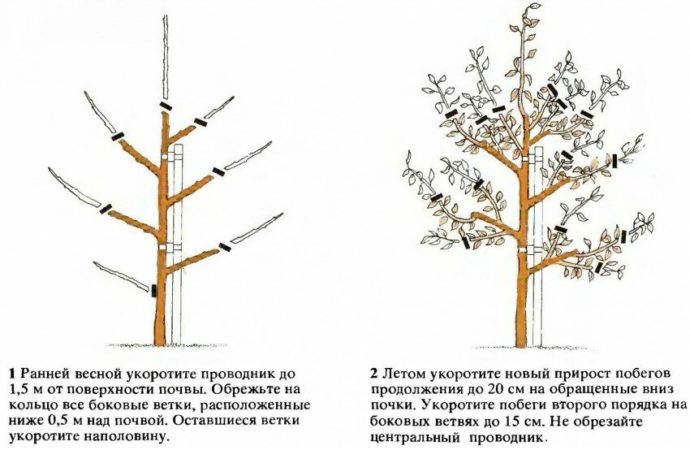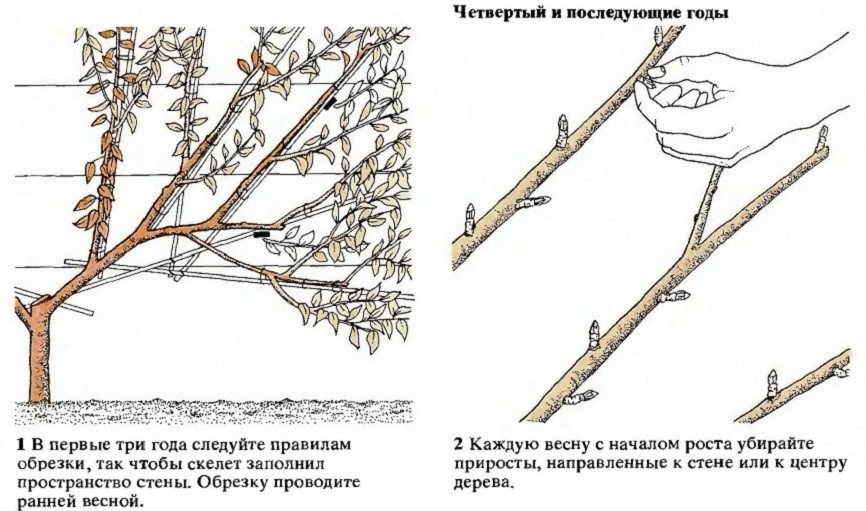Step-by-step instructions for pruning a plum tree in the summer with your own hands
To obtain a healthy, abundantly fruiting tree from a plum seedling, it is important to prune so that the crown is formed correctly. Many gardeners perform the procedure in the spring, giving the plant more time to recover before winter frosts. Let's consider whether it is advisable to form a crown in the summer if you did not have time to do it in the spring.
Is it possible to prune a plum tree in summer?
Pruning is carried out at any time of the year, except winter. This is done to maintain the health of the tree and abundant fruiting.
Too thick a crown prevents the plant from properly developing, making it more vulnerable to winter cold and susceptible to disease during the growing season.
In each season, including summer, specific goals and objectives are solved when pruning.

Purposes of summer plum pruning
Summer pruning, which is carried out in June and July, is suitable only for young seedlings. At this time, branches frozen in winter that were not discovered during the spring procedure are removed. Places where the crown is too thick and there are more branches become more noticeable. Such shoots are thinned out and shortened.
The procedure is carried out from the 2nd year of the plant’s life, and adult trees are pruned only when absolutely necessary.
Is this necessary?
Shaping and pruning in summer are mandatory for young plants; they allow you to achieve the following positive results:
- increasing frost resistance and reducing the risk of branches breaking under the weight of accumulated snow;
- eliminating excessive thickening of the crown, which will give the plant enough heat and light and increase productivity;
- branch growth in the right direction and a correctly formed crown, which simplifies harvesting.
Pruning in June helps the tree prepare to bear fruit. It protects against diseases and promotes the ripening of a bountiful harvest.
Deadlines
The timing of the procedure depends on the climate zone, weather, age and general condition of the plant. The milder the weather conditions, the later the pruning is carried out.
Reference. In the Moscow region, haircuts are completed in July, and in the Krasnodar Territory, where winter temperatures rarely drop below 0°C, at the end of summer and even early autumn.
Mature trees are pruned from early June to July, young plants - 20–30 days before the start of the growing season.
Types of pruning
Gardeners use several types of pruning:
- Forming - to create the shape of the above-ground part of the plant. It helps to increase the resistance to stress and longevity of the tree.
- Regulating - for access to the branches of light and heat.
- Rejuvenating - for the formation of new shoots, stimulating the development of dormant and adventitious buds.
- Restorative - to renew the functions of growth and fruiting.
- Sanitary - to remove diseased, damaged and dried branches.
Pruning plums in summer has a formative and sanitary significance, affects the size of the future harvest, protects against diseases and increases the lifespan of the tree.
How to trim a tree correctly

The first time a plant is formed is when planting. This procedure is carried out until the plant reaches approximately 15 years of age.
Important! Vertical branches do not bear fruit; they are disposed of first.
Next, only sanitary pruning is performed for high-quality and long-term fruiting.
Tools and materials
For beginning gardeners, this procedure is complex and responsible. In order not to harm the plant, it is important to carry it out according to the established scheme using well-sharpened, processed tools and high-quality materials. Old and dull blades can harm the plant.
To work you will need:
- pruner;
- lopper with long handles;
- garden saw;
- knife;
- a special solution or a self-prepared garden varnish for treating damage.
The cut should be smooth and neat, without burrs or irregularities. After completion of the work, it is treated with a special solution (for example, brilliant green, RanNet paste) or a self-prepared garden varnish.
To do this, mix 50 g of rosin and wax, 200 g of fat or vegetable oil, and boil for 30 minutes until dissolved. The resulting mass is mixed and poured into a storage container.
All cut branches damaged by fungus or insects are burned to prevent re-infestation.
Trimming schemes

In summer, plums are formed according to the following scheme:
- The main trunk of young medium-sized plants is shortened by 12–15 cm. In taller varieties, it is left no more than 2 m high.
- Remove 2/3 of the side branches by pinching off the 5th–7th leaf.
- Vertical fattening shoots located on the trunk or inside the tree are trimmed. As a result, the nutrition of fruiting branches is enhanced and their illumination is improved.
- Remove damaged, diseased, dry and frozen shoots, with signs of disease and affected by fungus.
- Remove shoots without fruits.
- At the end of June, the branches are cut down to the ring.
- Remove the emerging root shoots.This will increase the productivity of the plant.
The procedure has one goal - to stimulate the plant to further growth. Therefore, with sufficient growth of 40–50 cm, pruning is not necessary; you can limit yourself to removing diseased and dry branches.
If the growth is weak, you will have to trim:
- Bud pruning is done when it is necessary to change the direction of growth of a branch. To do this, find a bud on a young shoot located in the direction of pruning. The shoot is removed at a slight angle so as not to damage the bud and leave a stump above it.
- Shortening to a ring is performed when a powerful branch that is sick or growing improperly is cut off. It is removed with pruning shears to the base at an angle along the outer edge of the ring from the influx of bark.
- Side branch pruning is carried out when only one of several shoots is left so that it becomes a continuation of the main branch, and growth spreads to it.
Features of plum pruning
Not all trees are pruned and shaped the same way. The procedure varies depending on the age of the plant or growing region.
An adult plant is pruned in the summer, from early June to July. It is better to form young plants earlier, in the spring, so that they become stronger before the arrival of winter.
In Siberia, the Urals and the middle zone, pruning is carried out in spring and summer, so that the cuttings have time to tighten before the winter frosts and the plant does not die. In the southern regions, the procedure is carried out even at the beginning of autumn.
Further care of the plant
After pruning, the tree needs careful care:
- in hot weather it requires frequent watering: 3–5 times per season, 3 buckets of water per 1 m² of tree trunk circle;
- will support the plant by fertilizing with nitrogen during the period of fruit set, potassium and phosphorus after harvesting, as well as weeding and weed control;
- There are no severe frosts in summer, but the soil around the trunk should be loose and mulched, for which sawdust or straw is used.
The tree must have time to receive all the useful substances for abundant fruiting and prepare for the future wintering.
Advice from experienced gardeners
To grow a healthy, properly formed tree that will produce a rich harvest, gardeners recommend:
- Carry out minimal pruning after the first fruiting without removing healthy branches and thinning the crown.
- In the middle zone and northern latitudes, remove diseased and weakened shoots in spring and summer so as not to injure the crop before the winter cold. If the procedure is carried out too early or late, fruiting will decrease and the seedling may die.
- Form the crown of a young plant in the form of a bowl. This form is most favorable for the development and growth of the plant and helps increase productivity.
- Pruning should be carried out strictly according to the diagrams. Afterwards, be sure to feed the plant, loosen and mulch the soil.
- Treat plant cuts immediately to prevent fungal infection.
- Store garden tools in a dry place without access to moisture or condensation.
- Lubricate tools regularly to prevent rust. Rusty and dull equipment cannot be used.
- Disinfect pre-cutting surfaces with alcohol or potassium permanganate solution.
This is interesting:
Conclusion
Proper and timely pruning of plums increases its yield, prolongs the period of active fruiting and lifespan, and protects against diseases.
In order for the tree to fully recover before winter frosts, the procedure is carried out in the spring, but shaping and sanitary cuttings are also performed in the summer. In this case, it is important to strictly follow pruning patterns and properly care for the plant afterwards.